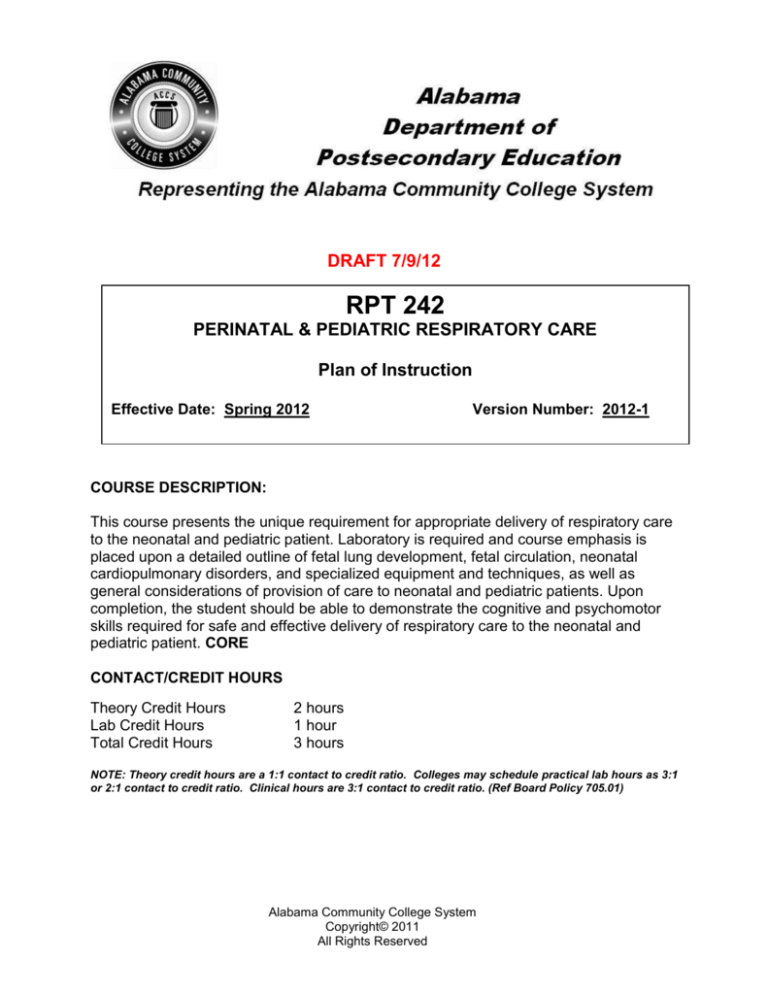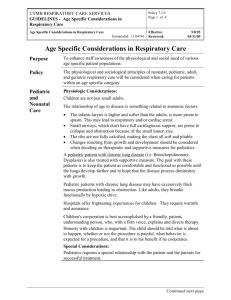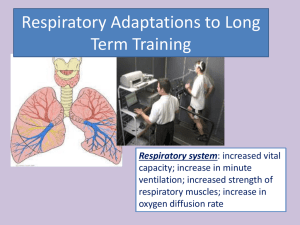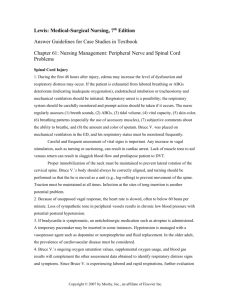
DRAFT 7/9/12
RPT 242
PERINATAL & PEDIATRIC RESPIRATORY CARE
Plan of Instruction
Effective Date: Spring 2012
Version Number: 2012-1
COURSE DESCRIPTION:
This course presents the unique requirement for appropriate delivery of respiratory care
to the neonatal and pediatric patient. Laboratory is required and course emphasis is
placed upon a detailed outline of fetal lung development, fetal circulation, neonatal
cardiopulmonary disorders, and specialized equipment and techniques, as well as
general considerations of provision of care to neonatal and pediatric patients. Upon
completion, the student should be able to demonstrate the cognitive and psychomotor
skills required for safe and effective delivery of respiratory care to the neonatal and
pediatric patient. CORE
CONTACT/CREDIT HOURS
Theory Credit Hours
Lab Credit Hours
Total Credit Hours
2 hours
1 hour
3 hours
NOTE: Theory credit hours are a 1:1 contact to credit ratio. Colleges may schedule practical lab hours as 3:1
or 2:1 contact to credit ratio. Clinical hours are 3:1 contact to credit ratio. (Ref Board Policy 705.01)
Alabama Community College System
Copyright© 2011
All Rights Reserved
Perinatal & Pediatric Respiratory Care
RPT 242
PREREQUISITE COURSES
As determined by college.
CO-REQUISITE COURSES
As determined by college.
PROFESSIONAL COMPETENCIES
Discuss gestational development and transitions at birth.
Discuss the importance of general perinatal and pediatric examination,
assessment, and history.
Discuss therapeutic interventions and modifications associated with common
neonatal and pediatric disorders.
Discuss pathogenesis, pathophysiology and treatment of common respiratory
diseases of infants and children.
Discuss the concepts of respiratory therapy in a non-traditional healthcare
setting.
INSTRUCTIONAL GOALS
Cognitive – Comprehend principles and concepts related to respiratory therapy
and pulmonary rehabilitation in the home and alternative settings.
Psychomotor – Apply knowledge of respiratory therapy and pulmonary
rehabilitation in the home and alternate healthcare settings.
Affective – Value the importance of adhering to policies and procedures related
to home health care and pulmonary rehabilitation.
STUDENT OBJECTIVES
Condition Statement: Unless otherwise indicated, evaluation of student’s attainment
of objectives is based on knowledge gained from this course. Specifications may be in
the form of, but not limited to, cognitive skills diagnostic instruments, manufacturer’s
specifications, technical orders, regulations, national and state codes, certification
agencies, locally developed lab/clinical assignments, or any combination of
specifications.
ACCS Copyright© 2011
All Rights Reserved
2
Perinatal & Pediatric Respiratory Care
RPT 242
STUDENT LEARNING OUTCOMES
MODULE A – FETAL DEVELOPMENT, ASSESSMENT, AND DELIVERY
MODULE DESCRIPTION – The purpose of this module is to teach the foundational
principles of respiratory therapy in the neonatal setting. Topics include fetal lung
development, fetal gas exchange and circulation, perinatal assessment, high-risk delivery,
and resuscitation.
PROFESSIONAL COMPETENCIES
PERFORMANCE OBJECTIVES
KSA
A1.0 Discuss gestational
A1.1 This module is measured
4
development and transitions at
cognitively.
birth.
LEARNING OBJECTIVES
A1.1.1 Discuss the importance of fetal lung development.
A1.1.2 Describe the cardiac and pulmonary sequences of events that occur
when transitioning from fetal to extrauterine life.
A1.1.3 Discuss the various high-risk conditions and their adverse effects on
pregnancy.
A1.1.4 Describe the steps of initial assessment of the newborn to determine the
need for neonatal resuscitation.
MODULE A OUTLINE:
KSA
4
4
4
4
A. Fetal Lung Development
Stages of lung development
o Alveolar cell development and surfactant production
o Fetal lung fluid
o Postnatal lung growth
Abnormal lung development
o Factors affecting prenatal and postnatal lung growth
o Pulmonary hypoplasia
B. Fetal Gas Exchange and Circulation
Maternal-fetal gas exchange
Embryonic cardiovascular development
o Fetal circulation and fetal shunts
o Transition to extrauterine life
C. Antenatal Assessment and High-risk Deliveries
Maternal history
o Risk factors
o High-risk conditions
Antenatal assessment of the neonate
o Intrapartum monitoring
o High – risk conditions
ACCS Copyright© 2011
All Rights Reserved
3
Perinatal & Pediatric Respiratory Care
RPT 242
D. Postnatal Assessment and Resuscitation
Stabilization of the neonate
Postnatal assessment of the neonate
Neonatal resuscitation
MODULE B – ASSESSMENT AND MONITORING OF THE NEONATAL AND
PEDIATRIC PATIENT
MODULE DESCRIPTION – The purpose of this module is to discuss the various methods
of patient assessment and diagnosis. Topics include neonatal and pediatric assessment,
chest x-ray interpretation, and diagnostic assessment tools and techniques.
PROFESSIONAL COMPETENCIES
PERFORMANCE OBJECTIVES
KSA
B1.0 Discuss the importance of
B1.1 This module is measured
4
general perinatal and pediatric
cognitively.
examination, assessment, and
history.
LEARNING OBJECTIVES
B1.1.1 Describe the elements of a normal neonatal patient examination and the
significance of abnormal findings.
B1.1.2 Discuss the use of historical and physical findings to develop a
differential diagnosis of a child’s respiratory condition.
B1.1.3 Examine the chest radiograph for proper placement of lines and/or the
recognition of chest abnormalities.
B1.1.4 Describe invasive and noninvasive diagnostic techniques.
KSA
4
4
4
4
MODULE B OUTLINE:
A. Examination and Assessment of the Neonatal Patient
Physical examination
o Vital signs
o General inspection
Chest
Abdomen
Head and neck
Musculoskeletal system, spine, and extremities
Cry
Gestational age/size assessment
Neurological assessment
Laboratory assessment
B. Examination and Assessment of the Pediatric Patient
Patient history
o Pulmonary examination
o Non-pulmonary examination
ACCS Copyright© 2011
All Rights Reserved
4
Perinatal & Pediatric Respiratory Care
RPT 242
o Laboratory testing
C. Radiologic Assessment
Radiographic technique
o Normal chest anatomy
o Positioning of lines and tubes
Abnormal conditions
o Airway obstruction
o Atelectasis
o Pneumonia
o Asthma
o Cystic fibrosis
o Acute respiratory distress
o Chest trauma
D. Diagnostic Assessment
Invasive monitoring and analysis methods
o Blood gas sampling/analysis
Arterial puncture
Arterial catheters
Capillary blood gas samples
o Venous blood sampling/analysis
Central venous catheters
Pulmonary artery catheters
o Clinical interpretations of lab values
o Hazards and Complications
Noninvasive monitoring in neonatal and pediatric care
o Pulse oximetry
o Transcutaneous monitoring
o Capnography
o Impedance pneumography
o Electrocardiography
o Calorimetry
o Clinical interpretations of lab values
o Hazards and Complications
Pediatric bronchoscopy
o Flexible vs. rigid
o Indications
o Contraindications
o Preparation
Equipment
Patient medication
o Hazards and complications
Pulmonary mechanics
o Neonatal pulmonary function testing
o Pediatric pulmonary function testing
Provocation testing
ACCS Copyright© 2011
All Rights Reserved
5
Perinatal & Pediatric Respiratory Care
RPT 242
Interpretation of data
MODULE C – THERAPEUTIC INTERVENTIONS FOR TREATMENT OF NEONATAL
AND PEDIATRIC DISORDERS
MODULE DESCRIPTION – This module discusses the most common therapeutic
interventions used to treat neonatal and pediatric disorders: oxygen therapy, aerosolized
and systemic medications, lung expansion techniques, airway management, ventilatory
support strategies, and alternative care considerations.
PROFESSIONAL COMPETENCIES
PERFORMANCE OBJECTIVES
KSA
C1.0 Discuss therapeutic
C1.1 Perform therapeutic interventions
3
interventions and modifications
and modifications as indicated by
associated with common
patient assessment.
neonatal and pediatric
disorders.
LEARNING OBJECTIVES
C1.1.1 Discuss the indications and contraindications for use of oxygen delivery
devices in the neonatal and pediatric populations.
C1.1.2 Discuss the wide range of medications available and the respective
modalities available for administration.
C1.1.3 Describe the basic fundamentals for managing mechanically ventilated
patients.
C1.1.4 Discuss lung ventilation strategies for a given pathophysiology.
C1.1.5 Discuss the techniques utilized in the treatment of a patient in respiratory
distress and respiratory failure.
MODULE C OUTLINE:
KSA
4
3
4
4
4
A. Oxygen administration
Indications
Complications
Methods of administration
B. Aerosols and administration of medication
Aerosol Characteristics
o Deposition of particles
o Drug dose distribution
Aerosol Delivery
o Pneumatic nebulizers
o Large-volume nebulizers
o Small-particle aerosol generator
o Ultrasonic nebulizers
o Vibrating mesh nebulizers
o Pressurized metered-dose inhalers
o Dry powder inhalers
ACCS Copyright© 2011
All Rights Reserved
6
Perinatal & Pediatric Respiratory Care
RPT 242
Factors affecting aerosol delivery
o Mechanical ventilation
C. Medications
Beta adrenergic agonists
Anticholinergics
Corticosteroids
o Inhaled
o Systemic
Leukotriene modifiers
Methylxanthines
Magnesium sulfate
Nonsteroidal anti-inflammatories
Mucolytic agents
Ketamine
Aerosolized antibiotics
Antiviral agents
Monoclonal anti-IgE antibody therapy
Surfactant
o Origin
o Physiology
o Clinical applications and replacement
Hyperosmolar aerosols
Insulin
D. Airway clearance techniques and lung volume expansion
Airway Clearance
o Patient selection
o Chest physiotherapy
Postural drainage and percussion
Coughing techniques
Forced expiration technique
Positive expiratory pressure therapy
Autogenic drainage
High-frequency chest compression
o Complications
o Contraindications
o Evaluation of therapy
Length
Patient monitoring
Modifications
Documentation
Lung Expansion
o Incentive spirometry
Indications
ACCS Copyright© 2011
All Rights Reserved
7
Perinatal & Pediatric Respiratory Care
RPT 242
Contraindications
Complications
o Intermittent positive pressure breathing
Indications
Contraindications
Complications
E. Airway management
Intubation/Extubation
o Indications
o Equipment
Endotracheal tubes
Cuffed vs. uncuffed
Laryngoscope blades and handles
Tracheostomy
o Indications
o Procedure
o Complications
o Decannulation
Suctioning
o Procedure
o Bulb suction
o Nasotracheal suction
o Closed-system suction
F. Mechanical ventilation
Indications
Types of ventilation
o Pressure ventilation
o Volume ventilation
Management strategies
o Waveform patterns
o Time constants
o Triggering
Flow
Pressure
Motion
Neural
Modes of ventilation
o A/C mode
o Synchronized intermittent mandatory ventilation
o Continuous positive airway pressure
o Airway pressure release ventilation
o Pressure support ventilation
o Inverse ratio ventilation
Hazards and complications
ACCS Copyright© 2011
All Rights Reserved
8
Perinatal & Pediatric Respiratory Care
RPT 242
o Overdistention
o Cardiovascular complications
o Oxygen toxicity
o Hypoventilation/hyperventilation
Weaning strategies
o Initiation
o Techniques of weaning
G. High frequency ventilation
Characteristics
Mechanisms of gas exchange
o Ventilation
o Oxygenation
Indications
Management strategies
o Ventilator settings
o Circuits and humidification
o Weaning
o Troubleshooting
Patient monitoring
o Positioning
o Therapeutic modifications
Suctioning
Surfactant replacement
Inhaled nitric oxide
Liquid ventilation
H. Special Considerations
Administration of gas mixtures
o Nitric oxide
o Helium – oxygen mixtures
o Hypoxic – hypercarbic gas mixtures
o Anesthetic mixtures
Extracorporeal life support
o Physiology
o Circuit/Treatment
o Management/monitoring
o Weaning
o Complications
Thoracic organ transplantation
o Complications
Pediatric advanced life support
o Respiratory distress/failure
Shock
o Rapid cardiopulmonary assessment
Appearance
ACCS Copyright© 2011
All Rights Reserved
9
Perinatal & Pediatric Respiratory Care
RPT 242
Airway/breathing
Circulation
MODULE D – NEONATAL AND PEDIATRIC DISORDERS: PRESENTATION,
DIAGNOSIS, AND TREATMENT
MODULE DESCRIPTION – The purpose of this module is to discuss the various diseases
and/or disorders that cause acute and chronic obstruction, and identify the symptoms,
diagnosis, and treatment options.
PROFESSIONAL COMPETENCIES
PERFORMANCE OBJECTIVES
KSA
D1.0 Discuss pathogenesis,
D1.1 Diagnose and treat patients
3
pathophysiology and treatment
according to common infant
of common diseases of infants
diseases and disorders.
and children.
Note: This module is measured
cognitively, and through computer
software and/or mannequin
simulation.
LEARNING OBJECTIVES
D1.1.1 Differentiate between the anatomical alterations associated with various
respiratory diseases and/or disorders.
D1.1.2 Describe the etiology and epidemiology of various respiratory diseases
and/or disorders.
D1.1.3 Describe the various diagnostic tests used to help identify the patient’s
condition.
D1.1.4 Identify the treatment options and techniques used in the management of
various respiratory diseases and/or disorders.
D1.1.5 Describe the benefits and risks of the various treatment options and
techniques used in the management of various respiratory diseases
and/or disorders.
D1.1.6 Discuss the appropriateness of each therapeutic intervention evaluated
for D1.1.4 and D1.1.5.
MODULE D OUTLINE:
A.
KSA
3
4
4
4
4
4
Neonatal pulmonary disorders
Respiratory distress syndrome
Transient tachypnea of the newborn
Pneumonia
Meconium aspiration syndrome
Persistent pulmonary hypertension of the newborn
Apnea of prematurity
B. Surgical disorders in childhood that affect respiratory care
Choanal atresia
ACCS Copyright© 2011
All Rights Reserved
10
Perinatal & Pediatric Respiratory Care
Macroglossia
Mandibular hypoplasia
Congenital diaphragmatic hernia
Chest wall malformations
Lung bud anomalies
Gastrochisis/omphalocele
Necrotizing enterocolitis
C.
Complications associated with respiratory care
Chronic lung disease
Retinopathy of prematurity
Intraventricular hemorrhage
RPT 242
D. Congenital cardiac defects
Cardiopulmonary anatomy and physiology
o Classification of cardiac anomalies
Congenital cardiac anomalies
E. Sleep disorders
Polysomnography
o Normal sleep development
Sudden infant death syndrome
o Home cardiopulmonary monitors
F. Pediatric airway disorders and parenchymal lung diseases
Upper airway disorders
o Choanal atresia
o Pierre Robin Syndrome
o Epiglottitis
o Laryngotracheobronchitis
Lower airway disorders
o Foreign body aspiration
o Bronchiectasis
o Acute bronchiolitis
o Primary ciliary dyskinesia
Respiratory Syncytial Virus
Sickle cell disease
Aspiration
G.
Asthma
Pathogenesis
Diagnosis
Management
H. Cystic fibrosis
ACCS Copyright© 2011
All Rights Reserved
11
Perinatal & Pediatric Respiratory Care
Genetics
Diagnosis
Pulmonary disease
o Treatment
o Other clinical manifestations
o Prognosis
I.
Special Considerations
Shock and Anaphylaxis
Sepsis and meningitis
Thermal and inhalation injury
Head injury and cerebral disorders
RPT 242
MODULE E – NEONATAL AND PEDIATRIC TRANSIENT AND AMBULATORY CARE
MODULE DESCRIPTION – The purpose of this module is to discuss the role of the
respiratory therapist in a non-traditional healthcare setting.
PROFESSIONAL COMPETENCIES
PERFORMANCE OBJECTIVES
KSA
E1.0 Discuss the concepts of
E1.1 This module is measured
4
respiratory therapy in a noncognitively.
traditional healthcare setting.
LEARNING OBJECTIVES
E1.1.1 Discuss and recognize the importance of transport team composition,
roles, and education.
E1.1.2 Discuss the importance of patient assessment in a non-traditional
environment.
E1.1.3 Discuss the considerations needed in the selection of home medical
equipment.
E1.1.4 Explain the proper patient/caregiver training necessary for various types
of home medical equipment.
MODULE E OUTLINE:
KSA
4
4
4
4
A. Transport of infants and children
Team composition
Modes of transportation
o Equipment
o Patient assessment and stabilization
o Patient safety
B. Home Care
Discharge planning
Equipment
o Oxygen therapy
o Apnea – bradycardia monitors
ACCS Copyright© 2011
All Rights Reserved
12
Perinatal & Pediatric Respiratory Care
RPT 242
o Pulse oximeters
Special considerations
o Tracheostomy patients
o Mechanical ventilation in the home
LEARNING OUTCOMES TABLE OF SPECIFICATIONS
The table below identifies the percentage of learning objectives for each module.
Instructors should develop sufficient numbers of test items at the appropriate
level of evaluation.
Limited
Knowledge and
Proficiency
1
Module A
Module B
Module C
Module D
Module E
ACCS Copyright© 2011
All Rights Reserved
Moderate
Knowledge
and
Proficiency
2
Advanced
Knowledge
and
Proficiency
3
20%
17%
Superior
Knowledge
and
Proficiency
4
100%
100%
80%
83%
100%
13
Perinatal & Pediatric Respiratory Care
Indicator
1
2
3
4
RPT 242
Learner’s Knowledge, Skills and Abilities
Key Terms
Description
Identifies basic facts and terms about the subject or
competency.
Limited
Knowledge Performs simple tasks associated with the
and
competency. Needs to be told or shown how to do
Proficiency
most tasks.
Requires close supervision.
Identifies relationship of basic facts and states
general principles and can determine step-by-step
Moderate
procedures for doing the competency.
Knowledge
and
Performs most parts of the competency. Needs help
Proficiency
only on hardest parts.
Requires limited supervision.
Analyzes facts and principles and draws conclusions
about the subject to include why and when the
Advanced
competency must be done and why each step is
Knowledge
needed. Can predict outcomes.
and
Performs all parts of the competency. Needs only a
Proficiency
spot check of completed work.
Requires little or no direct supervision.
Can evaluate conditions and make appropriate
Superior
decisions as related to resolving problems.
Knowledge
Performs competency quickly and accurately with no
and
direct supervision and is able to instruct and
Proficiency
supervise others.
ACCS Copyright© 2011
All Rights Reserved
14









